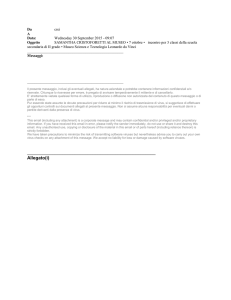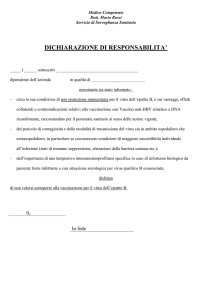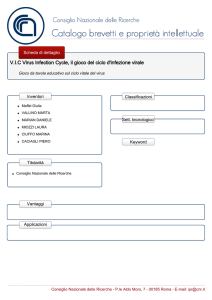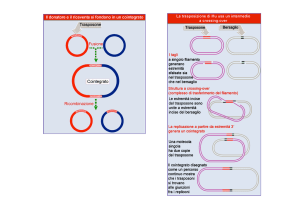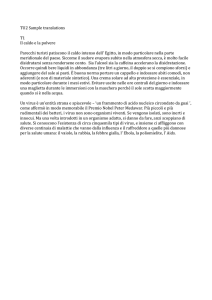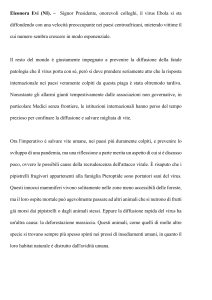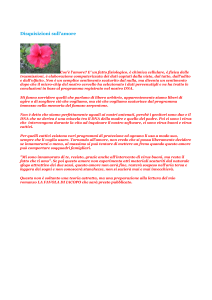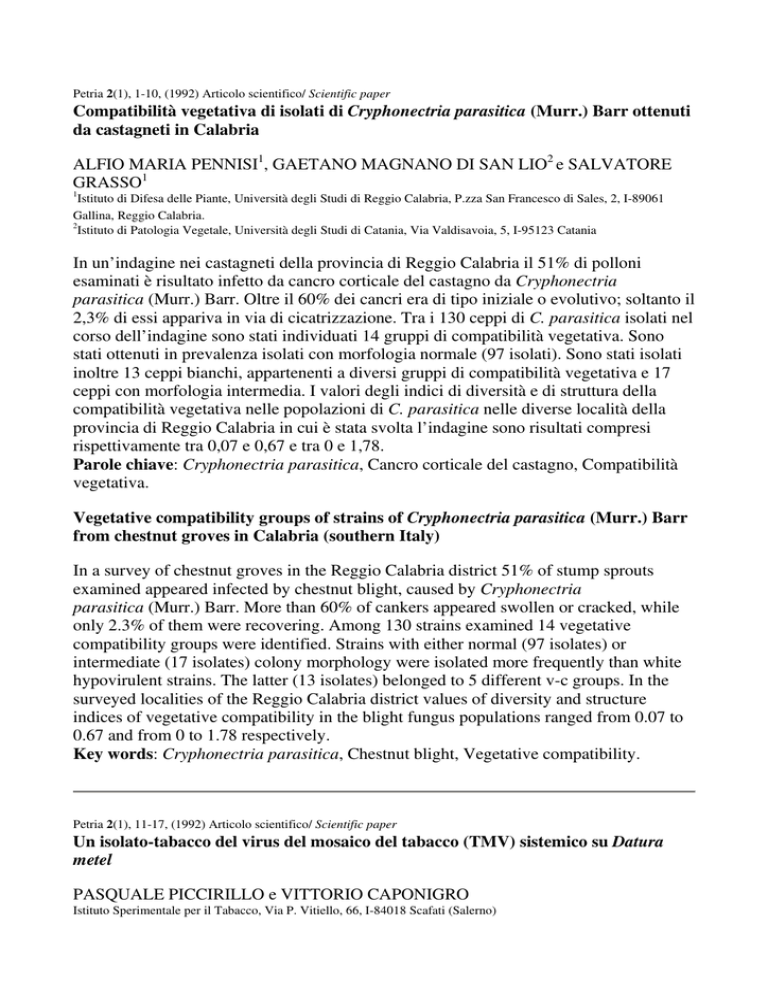
Petria 2(1), 1-10, (1992) Articolo scientifico/ Scientific paper
Compatibilità vegetativa di isolati di Cryphonectria parasitica (Murr.) Barr ottenuti
da castagneti in Calabria
ALFIO MARIA PENNISI1, GAETANO MAGNANO DI SAN LIO2 e SALVATORE
GRASSO1
1
Istituto di Difesa delle Piante, Università degli Studi di Reggio Calabria, P.zza San Francesco di Sales, 2, I-89061
Gallina, Reggio Calabria.
2
Istituto di Patologia Vegetale, Università degli Studi di Catania, Via Valdisavoia, 5, I-95123 Catania
In un’indagine nei castagneti della provincia di Reggio Calabria il 51% di polloni
esaminati è risultato infetto da cancro corticale del castagno da Cryphonectria
parasitica (Murr.) Barr. Oltre il 60% dei cancri era di tipo iniziale o evolutivo; soltanto il
2,3% di essi appariva in via di cicatrizzazione. Tra i 130 ceppi di C. parasitica isolati nel
corso dell’indagine sono stati individuati 14 gruppi di compatibilità vegetativa. Sono
stati ottenuti in prevalenza isolati con morfologia normale (97 isolati). Sono stati isolati
inoltre 13 ceppi bianchi, appartenenti a diversi gruppi di compatibilità vegetativa e 17
ceppi con morfologia intermedia. I valori degli indici di diversità e di struttura della
compatibilità vegetativa nelle popolazioni di C. parasitica nelle diverse località della
provincia di Reggio Calabria in cui è stata svolta l’indagine sono risultati compresi
rispettivamente tra 0,07 e 0,67 e tra 0 e 1,78.
Parole chiave: Cryphonectria parasitica, Cancro corticale del castagno, Compatibilità
vegetativa.
Vegetative compatibility groups of strains of Cryphonectria parasitica (Murr.) Barr
from chestnut groves in Calabria (southern Italy)
In a survey of chestnut groves in the Reggio Calabria district 51% of stump sprouts
examined appeared infected by chestnut blight, caused by Cryphonectria
parasitica (Murr.) Barr. More than 60% of cankers appeared swollen or cracked, while
only 2.3% of them were recovering. Among 130 strains examined 14 vegetative
compatibility groups were identified. Strains with either normal (97 isolates) or
intermediate (17 isolates) colony morphology were isolated more frequently than white
hypovirulent strains. The latter (13 isolates) belonged to 5 different v-c groups. In the
surveyed localities of the Reggio Calabria district values of diversity and structure
indices of vegetative compatibility in the blight fungus populations ranged from 0.07 to
0.67 and from 0 to 1.78 respectively.
Key words: Cryphonectria parasitica, Chestnut blight, Vegetative compatibility.
Petria 2(1), 11-17, (1992) Articolo scientifico/ Scientific paper
Un isolato-tabacco del virus del mosaico del tabacco (TMV) sistemico su Datura
metel
PASQUALE PICCIRILLO e VITTORIO CAPONIGRO
Istituto Sperimentale per il Tabacco, Via P. Vitiello, 66, I-84018 Scafati (Salerno)
Un’indagine è stata fatta per verificare la presenza di Tobamovirus in 63 campioni di
piante infette di tabacco. Il TMV "type strain" è risultato presente in 59 campioni, il
ToMV in 4 campioni. Due isolati del TMV "type strain" si sono differenziati dagli altri
per la formazione di mosaico su Datura metel, specie nota per la reazione necrotica
locale al TMV. In questi isolati la risposta delle altre piante test, le proprietà fisiche e
sierologiche sono risultate simili al TMV "type strain". Per la resistenza ai Tobamovirus,
espressa come reazione ipersensibile, (in pomodoro e peperone), sono comparsi nel
tempo nuovi ceppi virali capaci di sistemizzare, mentre non sono stati ancora riscontrati
ceppi di TMV in grado di sistemizzare su genotipi di N. tabacum con il fattore N.
Parole chiave: Tabacco, TMV, Reazione ipersensibile.
A tobacco isolate of tobacco mosaic virus (TMV) systemic on Datura metel
Sixty-three samples of tobacco were tested in glasshouse for Tobamovirus infections.
TMV "type strain" was detected in 59 samples, ToMV in 4 samples. Two TMV "type
strain" isolates were differentiated by Datura metel for causing mosaic on this species,
well known for necrotic local response to TMV. Physical and serological properties of
these isolates were similar to those of TMV "type strain". In tomato and pepper, the
resistance of hypersensitivity type has been frequently overcome by new systemizing
TMV strains, whereas no virus strain has been found to overcome the N type of
resistance in tobacco.
Key words: Tobacco, TMV, Hypersensitivity.
Petria 2(1), 19-27, (1992) Articolo scientifico/ Scientific paper
Evaluation of chemicals against Thielaviopsis basicola on tobacco in vitro and in soil
LAURA TOSI and ANTONIO ZAZZERINI
Istituto di Patologia Vegetale, Università degli Studi di Perugia, Borgo XX Giugno, 74, I-06100 Perugia
Of nine fungicides evaluated in vitro benomyl, thiabendazole, triadimenol and dazomet
inhibited mycelial growth of Thielaviopsis basicola, but only dazomet at 40 and 80 ppm
a.i. was fungitoxic. Fosetyl-Al and metham sodium greatly reduced fungal growth at 40
and 80 ppm ai., whereas iprodione, vinclozolin and tolclofos-methyl were only slightly
effective. The herbicides alachlor, metolachlor, metobromuron and pendimethalin were
more active against the fungus than diphenamid. Several chemicals applied as soil
drenches decreased the inoculum density of T. basicola after 45 days, but only benomyl
and dazomet totally eradicated the pathogen. In greenhouse trials tobacco black root rot
was greatly reduced by benomyl applied as soil drenches after sowing and by
triadimenol (10 and 20 ppm a.i.) applied 15 days before sowing; tolclofos-methyl and
fosetyl-Al, were ineffective. Triadimenol and fosetyl-Al, when applied immediately after
sowing, were phytotoxic. In a second experiment, triadimenol was more active when
applied by soil drench than by root immersion.
Key words: Tobacco, Thielaviopsis basicola, Fungicides, Herbicides.
Valutazione di alcuni fitofarmaci contro Thielaviopsis basicola su tabacco in vitro e
nel terreno.
Di nove fungicidi saggiati in vitro, benomyl, tiabendazolo, triadimenol e dazomet hanno
inibito lo sviluppo di Thielaviopsis basicola e solo dazomet a 40 e 80 ppm di p.a. è
risultato fungitossico. Fosetil-alluminio e metam sodio hanno ridotto notevolmente la
crescita miceliale a 40 e 80 ppm di p.a., mentre iprodione, vinclozolin e tolclofos-metile
sono stati scarsamente attivi. Alaclor, metolaclor, metobromuron e pendimetalin si sono
rivelati più efficaci del difenamide. Vari fitofarmaci, applicati al terreno, hanno
determinato un notevole decremento della densità di inoculo di T. basicola dopo 45
giorni ma solo benomyl e dazomet hanno totalmente eradicato l’inoculo del patogeno. In
prove in serra il benomyl, applicato al terreno dopo la semina del tabacco e il
triadimenol (10 e 20 ppm di p.a.) somministrato 15 giorni prima della semina hanno
ridotto notevolmente il marciume radicale; tolclofos-metile e fosetil-alluminio non sono
stati attivi. Triadimenol e fosetil-alluminio, applicati subito dopo la semina, hanno
manifestato effetti fitotossici. In un secondo esperimento il triadimenol è risultato più
attivo somministrato al terreno che somministrato direttamente alle radici delle piante.
Parole chiave: Tabacco, Thielaviopsis basicola, Fungicidi, Erbicidi.
Petria 2(1), 29-72, (1992)
Sixth Conference on Virus Diseases of Gramineae in Europe
Torino (Villa Gualino), Italy June 18-21, 1991
Organized by:
Istituto di Fitovirologia Applicata, Consiglio Nazionale delle Ricerche, Torino, Italy
Foreword
Members of the family Gramineae supply basic food to about three quarters of the
world’s population but can be affected by several viruses which sometimes reduce their
yield dramatically. The most dangerous world-wide is certainly barley yellow dwarf
virus, a luteovirus transmitted persistently by aphids and causing the ‘yellow plague’ of
cereals; other viruses, such as some transmitted by fungi (furoviruses) or by leafhoppers
(reoviruses, rhabdoviruses) are also economically important. Two examples of these in
Italy are soil-borne wheat mosaic virus, transmitted by Polymyxa graminis, and maize
rough dwarf virus, transmitted propagatively by the planthopper Laodelphax
striatellus.Another important group of Gramineae-infecting viruses includes maize
dwarf mosaic virus, sugarcane mosaic virus A and B, and other potyviruses which are
transmitted non-persistently by aphids and occur worldwide. Problems concerning the
identification, taxonomy, epidemiology and control of viruses of Gramineae were
discussed in Turin, Italy, during the ‘Sixth Conference on Virus Diseases
of Gramineae in Europe’ (Villa Gualino, 18-21 June 1991). This was organized by the
Istituto di Fitovirologia Applicata of the Consiglio Nazionale delle Ricerche, Turin,
following a decision made in Budapest by the European Working Group
on Gramineae Viruses (EWGGV) at the end of the previous Conference. The Group was
established about twenty years ago on the initiative of plant virologists from France,
Germany, Italy, Yugoslavia, Sweden and the U.K. and now includes about fifty
members from different countries. Its purpose is to encourage the co-operation and
exchange of information on research on Gramineae viruses between the members of the
Group. To this aim, meetings of the Group are organized periodically such as those held
in Belgrade (1974), Montpellier (1977), Rothamsted (1980), Braunschweig (1985) and
Budapest (1988). The Sixth Conference of Turin was sponsored by the Italian Ministry
of Agriculture and Forestry, the Region of Piedmont, the Province and Town of Turin,
the Consiglio Nazionale delle Ricerche – whose financial contributions are aknowledged
gratefully – the Italian Association of Plant Pathologists and the Academy of Agriculture
of Turin. The Scientific Committee of the Conference included M. Conti, G.P. Martelli,
A. Matta, R.G. Milne, A. Quacquarelli and E. Refatti, while the Organizing Commettee
included A. Appiano, G. Boccardo, P. Caciagli, M. Conti and V. Lisa. The Conference
was attended by scientists from eighteen different countries, including some extraEuropean for the first time which indicates the increasing interest of the Group’s field
world-wide. The Conference included six Sessions, namely:
1. Diagnosis and characterization of Gramineae viruses;
2. Epidemiology and control of Gramineae viruses;
3. Epidemiology and control of barley yellow dwarf virus;
4. Diagnosis and characterization of barley yellow dwarf virus;
5. Soil-borne viruses;
6. Maize viruses.
Each Session was introduced by an opening paper given by an invited speaker, and was
followed by offered papers. Altogether, forty-six papers were presented, and the
abstracts are collected in this Journal.
Maurizio Conti
Presentazione
Varie specie della Famiglia Graminaceae costituiscono nel loro insieme la base
alimentare di circa tre quarti della popolazione mondiale e possono essere infettate da
diversi virus che ne riducono drasticamente la produzione. Il più dannoso di questi in
tutte le regioni cerealicole è certamente barley yellow dwarf, un luteovirus trasmesso da
afidi in modo persistente, agente della cosiddetta ‘peste gialla’ dei cereali; diversi altri
virus, come alcuni trasmessi da funghi (furovirus) o da cicaline (reovirus, rhabdovirus)
sono pure di rilevante importanza economica. Due esempi di questi, per l’Italia, sono
soil-borne wheat mosaic virus, trasmesso daPolymyxa graminis, e maize rough dwarf
virus, trasmesso con modalità propagative dalla cicalina Laodelphax striatellus. Un
altro importante gruppo di virus delle graminacee include maize dwarf mosaic,
sugarcane mosaic virus A e B ed altri potyvirus trasmessi da afidi in modo nonpersistente e diffusi in tutto il mondo. I problemi relativi a identificazione, tassonomia,
epidemiologia e lotta dei virus delle graminacee sono stati discussi a Torino nel corso
della "IV Conferenza sulle virosi delle Graminacee in Europa" (Villa Gualino, 18-21
giugno 1991). Essa è stata organizzata dall’Istituto di Fitovirologia Applicata del
Consiglio Nazionale delle Ricerche di Torino e in seguito ad accordi definiti a Budapest
nell’ambito del Gruppo Europeo di Lavoro sui Virus delle Graminacee (EWGGV), in
conclusione della precedente Conferenza. Questo Gruppo, fondato circa vent'anni
orsono per iniziativa di virologi vegetali in Francia, Germania, Italia, Jugoslavia,
Svezia e Gran Bretagna, include oggi circa cinquanta membri di Paesi diversi. Sua
principale finalità è la promozione di collaborazioni e scambi di informazione e
materiale di studio tra i membri, in tema di virus delle graminacee. A tal fine sono
organizzati periodicamente convegni che hanno avuto luogo in passato a Belgrado
(1974), Montpellier (1977), Rothamsted (1980), Braunschweig (1985) e Budapest
(1988). La Sesta Conferenza di Torino ha avuto il patrocinio del Ministero
dell’Agricoltura e delle Foreste, della Regione Piemonte, della Provincia, del Comune
di Torino, del Consiglio Nazionale delle Ricerche – che si ringraziano per il contributo
finanziario – della Associazione Fitopatologica Italiana e della Accademia di
Agricoltura di Torino. Il Comitato scientifico della Conferenza è stato formato da M.
Conti, G.P. Martelli, A. Matta, R.G. Milne, A. Quacquarelli ed E. Refatti mentre il
Comitato organizzatore ha contato su A. Appiano, G. Boccardo, P. Caciagli, M. Conti e
V. Lisa. Alla Conferenza hanno partecipato ricercatori di diciotto Paesi, inclusi alcuni
extra-europei – per la prima volta nella storia del Gruppo – a testimonianza del
crescente interesse per l’argomento in tutto il mondo. La Conferenza si è articolata in
sei Sessioni, precisamente:
1. Diagnosi e caratterizzazione dei virus delle graminacee;
2. Epidemiologia e lotta dei virus delle graminacee;
3. Epidemiologia e lotta di barley yellow dwarf virus;
4. Diagnosi e caratterizzazione di barley yellow dwarf virus;
5. Virus trasmessi nel terreno;
6. Virus del mais.
Ogni Sessione è stata aperta da una relazione generale predisposta su invito, seguita da
comunicazioni libere. Nel complesso sono stati presentati quarantasei lavori scientifici i
cui riassunti sono raccolti in questa Rivista.
Maurizio Conti
Presented papers/ Lavori
presentati
Page/pagina
PAUL H.L. Diagnosis and characterization, some reflections.
33
MULLINEAUX Ph.M., . HOFER J.M.I, ACCOTTO G.P. Transcription and
DNA replication in cereal-infecting geminiviruses for producing host
resistance.
33
SHUKLA D.D., McKERN N.M., FRENKEL M.J., JILKA J. Immunological
and molecular approaches to identification and classification of potyvirus
35
infection in maize, sorghum and sugarcane.
GNUTOVA R.V.,SIBIRYAKOVA I.I., SAPOTSKY M.V., KAKAREKA
N.N., MOISEENKO L.I. Immunodiagnostics of cereal viruses in the Far
East.
36
FUCHS E., PROESELER G., OTTO F., HERRMANN G. Diagnosis of
SCMV, MDMV, BYDV, BaYMV and BaMMV using dot immunobinding
assay.
37
STEIN-MARGOLINA Vita A. Electron microscopy of cereals infected with
viruses.
38
GUGLIELMONE L., CACIAGLI P., MAGGIORE T., FOGLIANI G. Etiology
and epidemiology of a disease of seed maize in northern Italy (Cremona
province).
39
OSLER R., LOI N., REFATTI E., LORENZONI C., SNIDARO M.. On the
influence of barley yellow dwarf virus and maize dwarf mosaic virus, singly
or doubly infecting the B73 maize inbred line.
40
BORODINA E.E., KOSTIN V.D. Characteristics of a potyvirus
from Elytrigia repens.
41
THRESH J.M.. A comparative approach to the epidemiology of viruses
of Gramineae.
41
HELENIUS J., PELTONEN-SAINIO P., KARVONEN T. Testing of a
simulation model for estimating yield reduction of oats resulting from
barley yellow dwarf virus (BYDV) infection.
43
POCSAI E., MURÁNYI I, KOBZA S. Epidemiological occurrence of wheat
dwarf virus on barley breeding materials in Hungary.
44
HOLMES S.J., MASTERMAN A.J., FOSTER G.N., BELL A.,MILLS
P. Strategic monitoring: a crop-based approach to identifying BYDV high
risk.
45
LINDSTEN K. Wheat dwarf virus – host range and control.
45
MAMAEV P.Yu. Comparison of cereal mosaic virus with rhabdoviruses
from China and Japan.
46
TOŠIC M., MIJAVEC A.. Resistance of some sorghum genotypes to MDMV.
47
MIJAVEC A., TOSIC M., BERENJI J. Breeding of Broomcorn for resistance
to MDMV.
48
CACIAGLI P., GUGLIELMONE L., MINELLI L., ODASSO M.. Testing
maize hybrids for susceptibility to maize rough dwarf virus(a).
49
PLUMB R.T. Epidemiology and control of BYDV.
50
KARJALAINEN R., PELTONEN-SAINIO P. Disease development of barley
yellow dwarf virus (BYDV) on oat cultivar mixtures.
51
JASNIC S., BOSKOVIC M., FALAK I., BOSKOVIC J. Occurence of barley
yellow dwarf virus (BYDV) in Yugoslavia and the future research
program.
51
PELTONEN-SAINIO P., KARJALAINEN R. Barley yellow dwarf virus
(BYDV) as a limiting factor of oat production in Finland.
52
MEZZALAMA M., RANIERI R., BURNETT P.A. Annual variation in
serotypes of barley yellow dwarf viruses in cereals, in the Toluca valley of
Mexico.
53
COMAS J., PONS X., ALBAJES R., PLUMB R.T. Maize in barley yellow
dwarf virus (BYDV) epidemiology in Northeast Spain.
54
BURNETT P.A., RANIERI R., MEZZALAMA M..The effect of barley yellow
dwarf viruses on the yield of wheat in Mexico.
55
HUTH W., ZÜCHNER S. Behaviour of Lolium perenne to inoculations of
barley yellow dwarf virus (BYDV).
55
BURNETT P.A.. Diagnosis and characterizazion of barley yellow dwarf
viruses.
56
RANIERI R., BURNETT P.A. Titre of barley yellow dwarf viruses in spring
barleys.
57
FAVALI M.A., MUSETTI R., OSLER R., LOI N. Comparative study on
barley yellow dwarf virus infections in maize and oat plants.
58
BIANCHI G.L., COCEANO P.G., PERESSINI S. Application of ELISA to
maize infected with barley yellow dwarf virus.
59
GOLETTI T., DE PACE C., PORCEDDU E., SCARASCIA MUGNOZZA
G.T., LOI N., OSLER R. Response of a wide range of Triticeae species to
controlled barley yellow dwarf virus (BYDV) infection.
60
TOSIC M., BALAZ F. Barley yellow dwarf virus present in Yugoslavia.
60
GILMER D., SCHMITT C., JUPIN I., JONARD G., GUILLEY H.,
RICHARDS K. Infectious transcripts of beet necrotic yellow vein virus and
their use in investigating viral pathogenesis.
61
JIANPING C., ADAMS M.J., PLUMBR.T. Barley mild mosaic virus
detection inside Polymyxa graminis.
62
KUMMERT J., CHANDELIER A. Situation of barley yellow mosaic disease
in Belgium in 1990–1991.
63
RUBIES-AUTONELL C., VALLEGA V. Reactions of diploid
wheat, Triticum monococcum, to soil-borne wheat mosaic virus and wheat
spindle streak mosaic virus.
64
GÖTZ R., ORDON F., HUTH W., FRIEDT W. Genetic diversity of resistance
to the "barley yellow mosaic virus complex".
65
KRSTIC B., TOSIC M.. Contribution to the study of the potyviruses
infecting maize in Yugoslavia.
66
ACHON A., MEDINA V. Potyvirus infecting maize in Catalonia (Spain).
66
KOVACS Gy., MILINKO I., GYULAVARY O., HOANG N.D.,
GABORJANYI R. Damage caused by potyvirus infection in maize seed
production.
67
BALAZ F., TOSIC M.. Barley yellow dwarf virus, a new and important
pathogen of maize in Yugoslavia.
68
APPIANO A., CACIAGLI P., ADRIAN M.. Fine structure of maize rough
dwarf virus.
69
MARZACHÌ C., BOCCARDO G. Characterization of two genomic segments
of maize rough dwarf virus, a plant infecting reovirus.
70
LECLERCQ-LE QUILLEC F., DEDRYVER C.A , TANGUY S. Dynamics of
BYDV strains and their vectors in Brittany from 1989 to 1991.
70
BEUVE M., LAPIERRE H. Susceptibility to BYDV-PAV and to BYD-RPV
in the genus Bromus.
72

